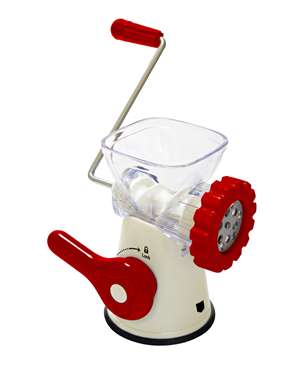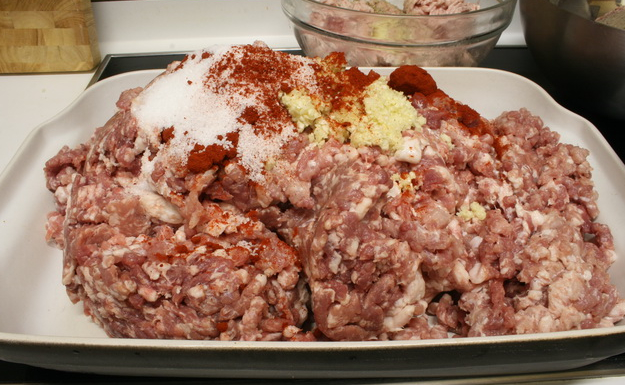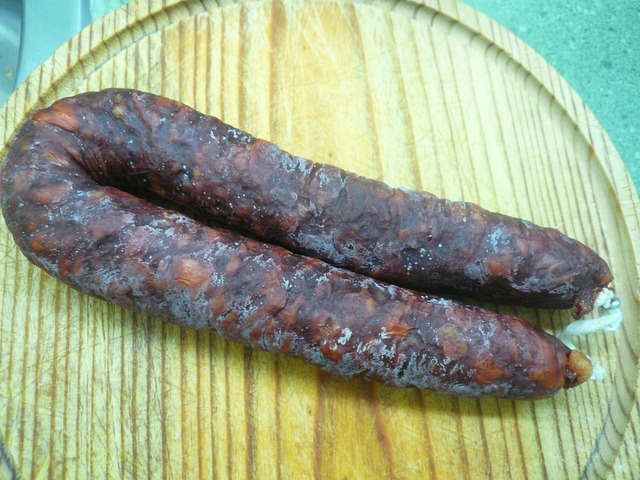 Here is one for all the meat lovers out there! From time immemorial the people of Spain have used salt, spices and fresh air to preserve sausages. Over the centuries these skills have been honed to an art, creating a myriad of unique chorizos, salchichones, morcillas and more. Smoked paprika, garlic, cayenne pepper and salt - simple ingredients that, when mixed with pork, create the spectacular Spanish sausages and there is no sausage that is more Spanish than the Chorizo. Although they may seem complicated they are in fact very simple to make yourself at home. Chorizo has always been one of my favourites, especially the hot spicy ones that combine perfectly with a slice of cured manchego cheese and a glass of red wine, an authentic Spanish titbit. Cured meats throughout the Mediterranean were being produced ever since the discovery of salt approximately 3000 years before Christ. However, Chorizo was probably one of the latest in arriving. Chorizo is chorizo thanks to the smoked Paprika, and this ingredient didn’t reach Spain until the XVI century after the Spanish discovered America, up until that time all cured meats were pale in colour or black if they had blood in them. So successful was this spice that it quickly spread all over Europe and Chorizo became one of the most popular cured sausages of the time and still is today.
Here is one for all the meat lovers out there! From time immemorial the people of Spain have used salt, spices and fresh air to preserve sausages. Over the centuries these skills have been honed to an art, creating a myriad of unique chorizos, salchichones, morcillas and more. Smoked paprika, garlic, cayenne pepper and salt - simple ingredients that, when mixed with pork, create the spectacular Spanish sausages and there is no sausage that is more Spanish than the Chorizo. Although they may seem complicated they are in fact very simple to make yourself at home. Chorizo has always been one of my favourites, especially the hot spicy ones that combine perfectly with a slice of cured manchego cheese and a glass of red wine, an authentic Spanish titbit. Cured meats throughout the Mediterranean were being produced ever since the discovery of salt approximately 3000 years before Christ. However, Chorizo was probably one of the latest in arriving. Chorizo is chorizo thanks to the smoked Paprika, and this ingredient didn’t reach Spain until the XVI century after the Spanish discovered America, up until that time all cured meats were pale in colour or black if they had blood in them. So successful was this spice that it quickly spread all over Europe and Chorizo became one of the most popular cured sausages of the time and still is today.
Chorizo is a typical Spanish sausage cured either by smoke or air, obviously, smoking is more complicated at home unless you happen to have a smoking house in your back yard, but fresh air is more than sufficient. They made with minced meat marinated in spices, of which the most popular is paprika, which gives it a red colour. The traditional season for homemade chorizo has arrived as the cold weather helps the drying of the sausages.
Homemade Spanish chorizo is normally made with the same ingredients in all provinces with the only difference being in the blend of spices used, which can vary from region to region, the main ingredients for chorizo are determined by the amount of lean pork used. These are guidelines as there must be hundreds of recipes for chorizo around the country and proportions can vary and so can your tastes and preferences.
So as a guide, for each kilo of lean pork we will need to add:
300g of pancetta / uncured bacon
20g of salt
1 clove of garlic – crushed
20g of Paprika
8g Cayenne Pepper (if you want it spicier increase the cayenne pepper and reduce the paprika proportionally to reach 28 grams combined or vice versa)
Pig intestine (available from butchers or some supermarkets)
Cotton string to tie the ends
Optional:
200ml dry white wine
1 tsp. dried Oregano
Other additions can be parsley, cumin, bay leaf and thyme.
During the chorizo elaboration process at an industrial level, other ingredients are added: ascorbic acid is added to accelerate colouration and to prevent the fat from oxidizing and maturation regulators are added as sweeteners to promote the maturation of the chorizo and speed up the whole process. So if you make it at home at least you know it is completely natural with no additives or preservatives. All you need is patience.
Chorizo can be encased in a wide intestine or in a narrow intestine. Its form can vary being straight, “chorizo de vela” or like a horseshoe – “chorizo sarta”, the latter being the most popular form used traditionally.
 To prepare chorizo at home you need lean pork such as pork shoulder or a “Boston butt” cut which is the high part of the shoulder of the pig. The first thing you need to do when making chorizo is to mix the meat thoroughly together with the fatty pancetta/uncured bacon. So this needs to cut up and coarsely minced. You can either get your butcher to do this or you can do it at home with a manual meat mincer or an electric one with a coarse cutting plate. You must bear in mind that the meat to make chorizo needs to be below 4ºC so the consistency is firm and you are able to cut it with a knife; it should also be checked that the temperature of the pancetta/bacon fat is between -2ºC and 2ºC to avoid melting during the mincing, leave the fat in the freezer for approximately 2 hours should be sufficient.
To prepare chorizo at home you need lean pork such as pork shoulder or a “Boston butt” cut which is the high part of the shoulder of the pig. The first thing you need to do when making chorizo is to mix the meat thoroughly together with the fatty pancetta/uncured bacon. So this needs to cut up and coarsely minced. You can either get your butcher to do this or you can do it at home with a manual meat mincer or an electric one with a coarse cutting plate. You must bear in mind that the meat to make chorizo needs to be below 4ºC so the consistency is firm and you are able to cut it with a knife; it should also be checked that the temperature of the pancetta/bacon fat is between -2ºC and 2ºC to avoid melting during the mincing, leave the fat in the freezer for approximately 2 hours should be sufficient.

 13.28.03 - Copy 1.png)
Secondly, when making the sausage at home, add the garlic, previously crushed in a mortar or a  13.29.00 - Copy 1.png) garlic crusher, add the salt and paprika/cayenne pepper; you can also incorporate a glass of dry white wine to help to mix and bind everything in together and make sure the mixture is as even as possible, so use your hands to do this. The chorizo mix must be left to stand for 24 hours in a cool place, which is why it's advisable to cover the mixing bowl with cling film or cotton cloths and put it in the fridge until the following day; then, with the help of a sausage filler or just a funnel, fill the intestines with the marinated mixture, trying not to leave air pockets and then tie them off at both ends with thick cotton string.
garlic crusher, add the salt and paprika/cayenne pepper; you can also incorporate a glass of dry white wine to help to mix and bind everything in together and make sure the mixture is as even as possible, so use your hands to do this. The chorizo mix must be left to stand for 24 hours in a cool place, which is why it's advisable to cover the mixing bowl with cling film or cotton cloths and put it in the fridge until the following day; then, with the help of a sausage filler or just a funnel, fill the intestines with the marinated mixture, trying not to leave air pockets and then tie them off at both ends with thick cotton string.
Finally, the chorizos must be pricked all over with a needle or a similar to remove possible air pockets that could have formed and then they are hung in a cool, dry and airy place leaving enough space between them that the air can reach the whole surface area and they will dry out properly in about three months; after this curing time the weight of the chorizo will have dropped by about 20% of its original weight. An ideal place would be an airy garage where you can hang them from a beam.

It is important to have in mind that the chorizos that are made at home do not contain preservatives, therefore it is important to control the curing of these sausages; the ideal drying conditions are areas with low humidity and cold temperatures, conditions that are perfect for curing meats. If the temperature and the humidity are too high they will not cure. In which case if you do live in a climate that is not very appropriate, you can just cure them for a week in a cool dry place and cook them on the barbecue or grill them. So as you can see its no more difficult than preparing a homemade beef burger.
Give it a go!